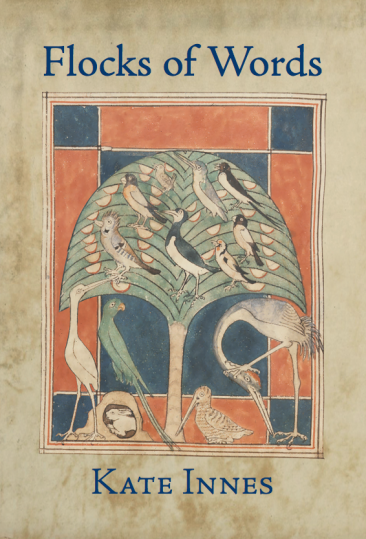I’m very grateful to Pat Edwards (website mashup arts ), organiser of Verbatim Poetry on the Welsh Border, for reading and reviewing my new collection – Flocks of Words. It’s a strange but satisfying feeling following another poet’s journey through one’s own work; finding some ideas that are very familiar, and others – startlingly new!
Flocks of Words – Kate Innes – reviewed by Pat Edwards
Writers who attempt the risky game of trying to describe the process of writing, or their love of language, may do so at their peril. Not so Kate Innes, who in the carefully crafted metaphor of the title poem depicts the reappearance of words as a cyclical event. Referring to Eden and to “god’s purpose”, we feel an echo of Luke’s advice about ravens as we stand “watching the words return”. We need not be concerned as we can feel the writer wanting to collect and nurture words, keep them safe whilst they are in her care, knowing they will fly away when the season demands.
In the five sections of this collection, Innes takes us on what many might make into an epic journey. The themes are the very stuff of creation and the pattern of decay and renewal that shapes the physical and spiritual landscape both. However, Innes adopts a kinder, more human touch as she quietly feels her way through the elemental, exploring paths, forests, time, water, firmament, light. Occasionally, she stops for breath as in ‘Breton House’, where “the old English painter” captures a pastoral scene.
In ‘Red Stag’ Innes imagines herself in the body of an animal, hunted until she is hit, “a flood of blood in (her) belly”. In ‘The Other Land’ she speaks of all “the places in between”, the silences, cracks, “like teeth behind a kiss”. The poet clearly loves the English landscape, its myths and legends, but also finds inspiration in art, ranging from the primitive as in ‘Reindeer Hunt’ to the more classic such as in ‘Virgin and Child’ where the exhortation of Luke to remain “unconcerned by cold and hunger” is re-visited.
Parts iii and iv focus on water, the hunter and the prey, animals and evolution. Always death lurks, even in the fleece worn by the spring lamb, “that supple shroud”. In the final part, a sequence of poems inspired by the stained glass of Margaret Agnes Rope, Innes is never far from light, animals, water, the familiar themes of this collection.
In all, there is much to please and excite the reader, especially if you share her fascination with the existential and with how we make sense of our place in a changing natural world. I enjoyed the collection as it made me reconsider some of these ideas from a new perspective and exposed me to the poet’s own unique and very beautiful mastery of language.

